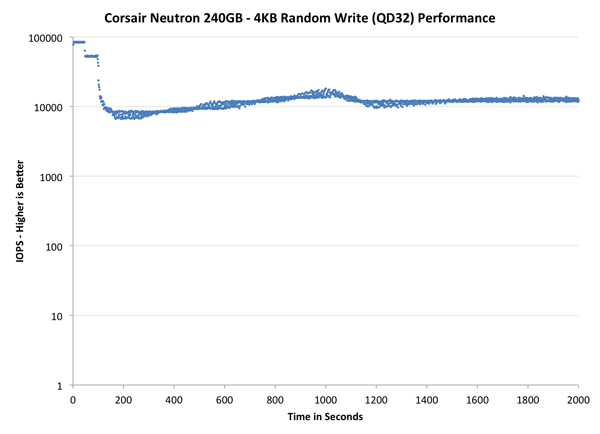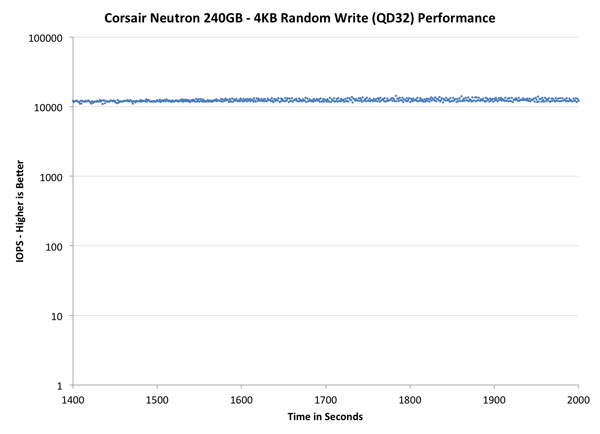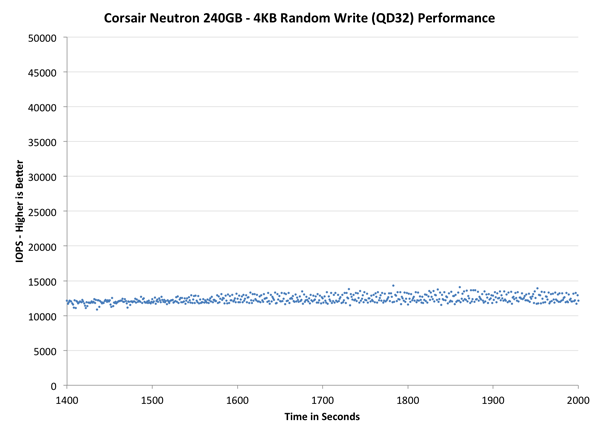Corsair Neutron & Neutron GTX: All Capacities Tested
by Kristian Vättö on December 19, 2012 1:10 PM ESTPerformance Consistency
If you read our Exploring the Relationship Between Spare Area and Performance Consistency in Modern SSDs article, you have seen the performance consistency data for Neutron already and the data here should be nothing new. However, because we didn't have any performance consistency results in our initial Neutron review, I wanted to focus on it here.
We started paying attention to performance consistency when Intel launched the DC S3700 because Intel specifically highlighted its low latencies, which translate to consistent performance. Consistency has been a big selling point in the enterprise market for a long time now, but that has not yet transferred to the consumer SSD market. Given LAMD's enterprise focused history, I was eager to find out how the LM87800 would do in this regard.
To generate the data below I took a freshly secure erased SSD and filled it with compressible sequential data (incompressible for Intel SSD 335) . This ensures that all user accessible LBAs have data associated with them. Next I kicked off a 4KB random write workload at a queue depth of 32 using incompressible data. I ran the test for just over half an hour, no where near what we run our steady state tests for but enough to give me a good look at drive behavior once all spare area fills up.
I recorded instantaneous IOPS every second for the duration of the test. I then plotted IOPS vs. time and generated the scatter plots below. Each set of graphs features the same scale. The first two sets use a log scale for easy comparison, while the last set of graphs uses a linear scale that tops out at 40K IOPS for better visualization of differences between drives.
The first set of graphs shows the performance data over the entire 2000 second test period. In these charts you'll notice an early period of very high performance followed by a sharp dropoff. What you're seeing in that case is the drive alllocating new blocks from its spare area, then eventually using up all free blocks and having to perform a read-modify-write for all subsequent writes (write amplification goes up, performance goes down).
The second set of graphs zooms in to the beginning of steady state operation for the drive (t=1400s). The third set also looks at the beginning of steady state operation but on a linear performance scale. Click the buttons below each graph to switch source data.

The Neutron is extremely consistent. After the first burst, the performance variation is very small compared to for example OCZ Vector and Samsung SSD 840 Pro, although it should be noted that the Neutron comes with 12% over-provisioning by default while Vector and 840 Pro have only 7% of the capacity reserved for OP. The amount of OP can have an enormous effect on consistency but if that extra consistency is only due to the extra OP Corsair and LAMD has set aside, then it's been a great decision. Out of the consumer-grade drives, only Intel SSD 335 is more consistent but SandForce has always performed well when it comes to steady-state performance.

When focusing on the last 10 minutes of the test where most SSDs have reached steady state, the Neutron is exceptional. While all other SSDs in this test including the enterprise focused Intel S3700 have noticeably variation in IOPS, the Neutron does not. The variation is only around 2-3K IOPS, whereas for Intel SSD 335 it's up to 25K IOPS. The steady state performance in general is also great; Vector and 840 Pro have an average IOPS of ~5-8K while the Neutron manages to push 12-13K IOPS. Intel DC S3700 is obviously in its own class but again, keep in mind that it also has significantly more OP than the other SSDs in this test. When the Neutron is given about as much OP as the S3700, they perform about the same.

Neutron's ability to retain performance and consistency over time is definitely appreciated and it's the most consistent consumer-grade SSD at the default OP we have tested. SandForce based SSDs can push much higher peak IOPS but the variation is in the magnitude of tens of thousands of IOPS. While the SSD 335 has higher IOPS on average, it drops below 10K right after 30 minutes of 4KB random writes but the Neutron is able to sustain a throughput of 12-13K throughout the last ten minutes of the test.










44 Comments
View All Comments
infoilrator - Thursday, December 20, 2012 - link
Better in what way?Perceived, benchmark, or price?
Raid0 with another Kingston might be the most cost effective.
The SAMSUNG 840 certainly offers a lot for the price
celestialgrave - Thursday, December 20, 2012 - link
Guess I'll be sticking with my Agility 3 a while longer in the laptop, until someone releases a more frugal powered ssd with good performance.lmcd - Monday, December 24, 2012 - link
... Samsung 840 sips. Doesn't Sandforce take a lot of power?lmcd - Monday, December 24, 2012 - link
Whoops, nvmwell, OCZ 4 series does better than 3 series, either way. And Samsung's results may be faked, as per Oxford Guy's comments.
pattycake0147 - Thursday, December 20, 2012 - link
Why did you choose different scales on the graphs for the final set of consistency graphs? Some top at 50,000 iops and others top at 40,000 iops this makes looking at comparisons more difficult. Even the same drive (840 Pro) has a different scale for the standard and 25% OP graphs.Kristian Vättö - Friday, December 21, 2012 - link
I was aware of this. At first 40K IOPS was enough but when we started including 25% OP tests, many SSDs managed over 40K IOPS so it was obvious that the scale had to be extended. I'll try to make all graphs 50K IOPS for the next review - Anand has done most of the tests so I couldn't create new graphs for this one.Oxford Guy - Friday, December 21, 2012 - link
Anandtech should expose Samsung's lies, regarding the load power usage of their SSDs.It certainly does not here:
"the 840 Pro boasts incredibly low power consumption both at idle and under load"
Perhaps, but the actual usage is much higher than Samsung's packaging claim.
http://www.anandtech.com/show/6328/samsung-ssd-840...
Or here:
"Until we get lower capacity drives it's impossible to tell how much the power consumption story will change."
How convenient it was for Samsung to only provide a 512 GB unit.
http://www.anandtech.com/show/4863/the-samsung-ssd...
Let's see what Samsung claims with their "full specs" page:
http://www.samsung.com/us/computer/memory-storage/...
.13W — miraculous!
And, let's see what Samsung provided Newegg for its 512 GB drive, eh?
Power consumption idle: .008W
Power consumption load: .13W
http://www.newegg.com/Product/Product.aspx?Item=N8...
People have routinely cited Samsung's "efficient" design, citing these false numbers, in comparisons with other drives. This has to stop. Anandtech, you have a responsibility to report on this, not cover for them.
Let's see what the 840 512's "full specs" are, eh?
http://www.samsung.com/us/computer/memory-storage/...
Well, Samsung certainly learned their lesson thanks to Anandtech. They've raised the power consumption to .15W!
Oxford Guy - Friday, December 21, 2012 - link
Oh, and let's take a look at the numbers Samsung provided Newegg for the 512 GB 840, shall we?power consumption idle: 0.054W
power consumption load: 0.069W
Oxford Guy - Friday, December 21, 2012 - link
OCZ has felt heat from Anandtech over its sleazy practice of changing the NAND of its drives from 32-bit to 64-bit without changing the specs on the packaging.Why not Samsung? The 830 has the highest power consumption in this latest roundup, and yet did Anandtech compare the claimed .13W power usage to the actual power usage?
"Until we get lower capacity drives it's impossible to tell how much the power consumption story will change."
How about "This 512 GB drive uses vastly more power than Samsung claims it does. We are going to find out just how much the lower-capacity drives use and write a story about these serious discrepancies."?
That would have been more appropriate.
derGhostrider - Saturday, December 22, 2012 - link
What is your problem "Oxford Guy"?Almost noone cares about power consumption of 1W or 3W or 0.15W for a SSD, except when you try to build an ultra durable ultra-book or tablet PC.
But even then you have to consider that the Samsung 840 pro has the lowest "disk busy time" of all SSDs tested so far.
So it uses more power during its active time but it shortens this time to a minimum.
Take a calculator! It won't be that bad compared to others that use less power but twice as long.
And, if you really care about this little secondary detail that much: Take another SSD that offers the lowest overall power consumption. It won't be that fast but it will satisfy your needs.
Your postings look like a senseless try of bashing the best SSD on the (consumer) market for an almost unimportant little detail. And: You seem to know about it. So make your decision based on your knowledge but don't tripple post just to arouse the image of an issue that might be important.